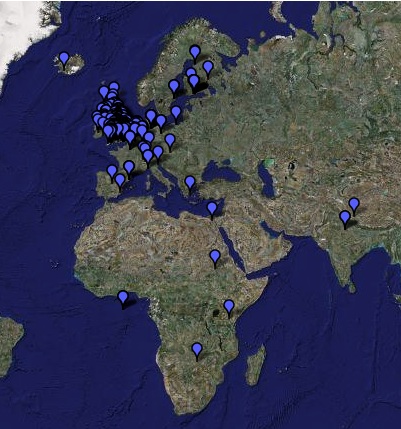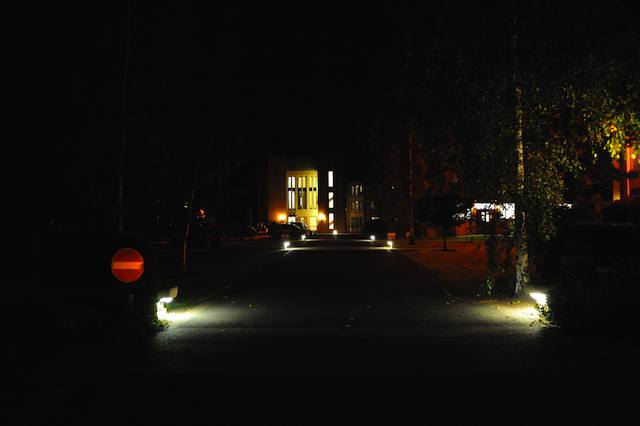Wow! This is interesting. Wikipedia for biologists: inspired by E.O. Wilson. “Imagine”, he says, “an electronic page for each species of organism on Earth, available everywhere by single access on command.”
Category Archives: Technology
Album Covers Map
Here’s a really neat mashup.

Word Magazine readers have been busy building a map showing where iconic album cover photographs were taken.
$5,000 for your genome
From Technology Review…
Starting next spring, a complete human-genome sequence can be ordered for just $5,000, thanks to a new sequencing service announced by Complete Genomics, a startup based in Mountain View, CA. The stunning price drop–sequencing currently costs approximately 20 times that amount–could completely change the way that human-genomics research is done and open up new possibilities in personalized medicine. Researchers say that a $5,000 genome would enable new studies to identify rare genetic variants linked to common diseases, and it could open up the sequencing market to diagnostic and pharmaceutical companies, making genome sequencing a routine part of clinical drug testing.
Complete Genomics, which has received $46 million in venture funding to date and has largely stayed under the radar, plans to launch with a bang and anticipates the capacity to sequence 1,000 genomes in 2009 and 20,000 in 2010. That would represent a massive jump: with a price tag of $100,000 to $1 million over the past two years, only a handful of human genomes have been sequenced to date.
Apart from anything else, this is an illustration of what Moore’s Law can do.
Robbery 2.0
Lovely story in Good Morning Silicon Valley…
As a rule, most criminals are not particularly bright, a fact that gives law enforcement a fighting chance against lousy odds. But once in a while you see a little flash of cleverness that has to be abstractly appreciated despite the way that it was employed. Taking inspiration from similar ploys seen in the movies and adding a Web 2.0 twist, an armored-car robber in Monroe, Wash., escaped Tuesday with the unwitting help of a dozen or so decoys responding to a Craigslist job ad.
According to reports, the suspect — wearing a yellow vest, safety goggles, a blue shirt, and a respirator mask — approached the truck in a Bank of America parking lot, gave the guard a face full of pepper spray, grabbed the cash bag, sprinted about 100 yards to a creek, hopped into a waiting inner tube and floated off to freedom. The getaway vehicle was later found about 200 yards downstream, sans passenger. At the bank, meanwhile, there was no shortage of people matching the robber’s description. A dozen or so men dressed in identical gear were wandering around wondering if their potential employer had stood them up. Each had responded to a Craigslist ad purportedly seeking to hire road maintenance workers for $28.50 an hour, and each had gotten e-mail instructions to show up at 11 a.m. Tuesday near the bank wearing certain work clothing — “yellow vest, safety goggles, a respirator mask … and, if possible, a blue shirt,” said one. The FBI is on the case, hoping the offender was less clever in covering his digital tracks.
Nightlight

The new Nikon D3/D700 sensor is amazing. This is a handheld shot at 6400 asa.
User-generated science
This is the headline on an interesting piece in last week’s Economist about the effect of the web on scientific publishing. Excerpt:
Peer-review possesses other merits, the foremost being the ability to filter out dross. But alacrity is not its strong suit. With luck a paper will be published several months after being submitted; many languish for over a year because of bans on multiple submissions. This hampers scientific progress, especially in nascent fields where new discoveries abound. When a paper does get published, the easiest way to debate it is to submit another paper, with all the tedium that entails.
Now change is afoot. Earlier this month Seed Media Group, a firm based in New York, launched the latest version of Research Blogging, a website which acts as a hub for scientists to discuss peer-reviewed science. Such discussions, the internet-era equivalent of the journal club, have hitherto been strewn across the web, making them hard to find, navigate and follow. The new portal provides users with tools to label blog posts about particular pieces of research, which are then aggregated, indexed and made available online.
Although Web 2.0, with its emphasis on user-generated content, has been derided as a commercial cul-de-sac, it may prove to be a path to speedier scientific advancement. According to Adam Bly, Seed’s founder, internet-aided interdisciplinarity and globalisation, coupled with a generational shift, portend a great revolution. His optimism stems in large part from the fact that the new technologies are no mere newfangled gimmicks, but spring from a desire for timely peer review…
The loudness wars
Terrific video by Matt Mayfield, a music teacher who is fed up with the way bands are compressing the dynamic range of recordings.
A web server on a business card

Neat, eh? From Hack a Day
Tag clouds: the silver lining

I love tag cloud generators. Wordle, created by Jonathan Feinberg, is the nicest I’ve come across. This is a cloud from some transcripts I’ve been doing for the just-launched Arcadia Fellowship Project, for which I’m Academic Adviser.
TBL and web-based disinformation
From BBC NEWS …
The internet needs a way to help people separate rumour from real science, says the creator of the World Wide Web.
Talking to BBC News Sir Tim Berners-Lee said he was increasingly worried about the way the web has been used to spread disinformation…
